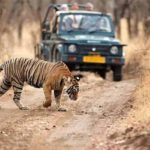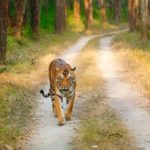Monsoon Travel in Ranthambore National Park is a superb wildlife tourism destination in the world where you can see wildlife and Tigers in a dry deciduous forest setting. The Ranthambore Tiger Reserve is open from October to June, and all national parks in India are closed for the next three months, July, August, and September, due to the rainy season, but it should be mentioned that a few tourist safari zones are open during this time in During the Monsoon season,
the Ranthambore Tiger Reserve, which includes zones 06, 07, 08, 09, and 10, remains open all year, allowing wildlife enthusiasts to enjoy a magnificent Monsoon travel experience in Ranthambore while exploring animals and witnessing tigers in their own region. If there is a lot of rain in the area, The Department of Forestry has the authority to close safari zones and cancel safaris for non-refundable and non-transferable fees.
These Monsoon zones feature beautiful scenery and good tiger sightings, yet tiger sightings are not guaranteed. There are three tiger territories in Zone 06, as well as two new born cubs (T-24 or ustad, T-39 or or Noor, T-72 or Sultan and 02 little cubs of T-39, which is recently sighted). T-08, often known as Ladli, and her 02 cubs have territory in Ranthambore’s zones 07 and 8. If you are in Zones 09 or 10, you will have a good opportunity of seeing other Ranthambore National Park stars, such as T-42 (Fateh), a male tiger. At this time, we wish Ranthambore a joyful and safe Monsoon Travel in Ranthambore National Park.
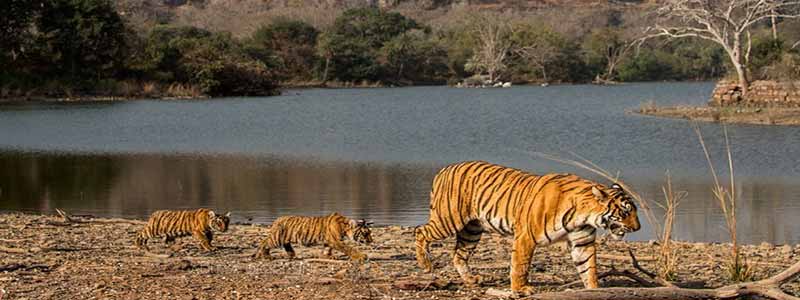
WHAT TO CARRY WHILE VISITING RANTHAMBHORE
- Snacks and Water– When set for a whole day’s trip, always carry snacks and water that will not let you starve in some secluded place. Staying hydrated during the course of your tour is fairly needed.
- Sunscreen and Sunglasses – Come summer or winter, it is essential to protect your skin and shelter your eyes from blistering sun and dust.
- Sun Hats/ Umbrella – To shield you and keep your head cool from the sun, wide-brimmed hat/ umbrella is a must in both seasons.
- Binoculars – A pair of binoculars will help you get a fine view of the eccentric fauna.
- Camera – No trip is ever complete without capturing the mystic moments. Along with the camera do carry stands, extra batteries, and memory cards.
- Power Bank – You may not find plug-ins to charge your gadgets, therefore, carry power bank as a backup for your smartphones and other devices.
Top Attractions In Ranthambore
Ranthambore, or Tiger Land, is one of India’s most well-known wildlife sites. Ranthambore Tiger Reserve is one of India’s best tiger reserves. Tigers and a variety of other plants and creatures call this wild world home. The Ranthambore Tiger Reserve is located in Rajasthan’s Sawai Madhopur region, in the western part of the country, and is easily accessible from Jaipur, Delhi, Mumbai, and Agra are three of the most important cities in India.
All major railway routes connect Ranthambore; the nearest railway station is Sawai Madhopur, and the nearest airport is Jaipur. Check out our selection of the greatest locations to visit in Ranthambore Tiger Reserve if you’re looking for a relaxing vacation in this natural paradise. In Ranthambore, there are many interesting things to visit. Clearly, the tourist attractions of Ranthambore may be seen in conjunction with the local people’s way of life. If you’re not sure whether you should include Ranthambore in your itinerary, let us give you a rundown of the Monsoon Travel in Ranthambore National Park.
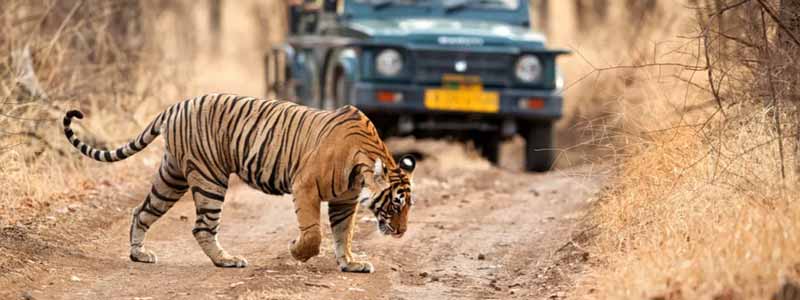
Ranthambore National Park
Ranthambore National Park is the state’s first important tourism attraction. It is widely regarded as the best location in the world for wildlife photography. Here you can discover various animal moods and moments. Ranthambore was once regarded as the Maharaja of Jaipur’s hunting lodge, but it is now one of the top wildlife sites in the region, attracting visitors from all over the world year pulled the attention of the millions of wildlife lover and traveler. Because of its rocky terrain, the Ranthambore National Park’s forest is tropical thorn and dry deciduous. During your Jungle Safari in Ranthambore National Park, you can see wildlife.
Bookings for Ranthambore safaris can be made up to 365 days in advance of the visit date. (In Ranthambore, you can now book an internet safari 365 days in advance rather than 90 days.) This new safari booking system will be available from September 15, 2018. (See the article.) From October through June, there are two jungle safari slots available every day, and the park is open seven days a week. The schedule of a Ranthambore Jungle Safari is determined by the dawn and sunset, Monsoon Travel in Ranthambore National Park.
Morning safaris begin when the sun is low in the sky – early in the morning – and afternoon safaris begin in the late afternoon. There are two types of safari vehicles: six-seat jeeps and twenty-seat canters, which are open safari buses. Both safari vehicles go in the same sector and stop at the same wildlife viewing location.
- An ideal time to visit: March is a great month for wildlife viewing and when the temperature is not very high. Entry fee is applicable.
- Do look out for: A variety of Striped Hyenas, Tigers, Sambar Deer and Indian False Vampires
- Other Available Facilities: Camera/video is allowed inside, option of lockers/storage
- Timings: 6.00 AM to 6.00 PM
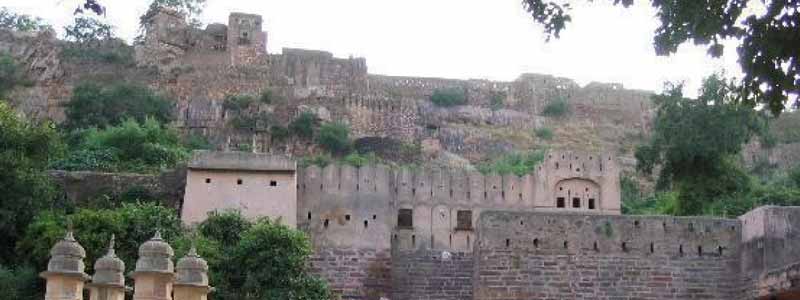
Ranthambore Fort
The Ranthambore Fort is a landmark of the Ranthambore National Park, located adjacent to the Ranthambore Tiger Reserve. Ranthambore fort is one of the six forts listed in the World Heritage Site inscription Hill Forts of Rajasthan and is located approximately fourteen kilometres from Sawai Madhopur railway station. The Chauhan dynasty’s miracle is Ranthambore Fort. The Nagil Jats are said to have founded Ranthambore Fort around 944 AD, but the Ranthambore Fort rose to prominence when Hammir Dev Chauhan became King.
Ranthambore Fort, perched on a remote “Thambhore” hill. It is 1578 feet above sea level and adjoins hill “Ran,” which provides a spectacular view from Thambhore Hill. The 32-pillar cenotaph, Supari Mahal, Dullah Mahal, Badal Mahal, Hammir Court, Tomb, Mausoleum, and Step Wells are the most enchanting features of the Ranthambore Fort. The fort of Ranthambore is one of the Monsoon Travel in Ranthambore National Park and is well worth a visit.
- Do look out for: Ganesh Mandir, a rather prominent temple, located at the main gate of the fort and Battis Khamba Chattri which is a dome supported by 32 pillars.
- Interesting fact about the place: When Raja Hammir Singh, the ruler, lost the battle in 1302 A.D., thousands of women committed Jauhar (mass suicide) in this fort.
- Summer Timings: Mornings- 6 AM to 9:30 AM and Afternoon- 2 PM to 5:30 PM
- Winter Timings: Mornings- 7 AM to 10:30 AM and Afternoon: 3:30 PM to 7 PM
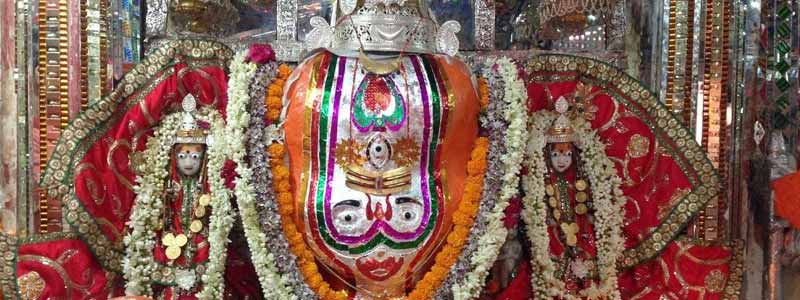
Trinetra Ganesh Temple
Ranthambore At the Ranthambore Tiger Reserve, there is a Ganesh temple called Trinetra. Trinetra (Three-Eyed) Ganesh Temple is located near Ranthambore Fort and is dedicated to Lord Ganesha. Ranthambore National Park now has yet another tourist draw. It is a heartfelt location for Ganesha enthusiasts and an ancient temple where Lord Ganesha can be found with his entire family, his wife Riddhi Siddhi and two sons Subh and Labh. According to mythology, there was a large-scale conflict between King Hammir and Alauddin Khilji in 1299 AD. King Hammir of Monsoon Travel in Ranthambore National Park was at war, and the grain godown and food reserves were nearly depleted.
Hammir was a great devotee of Lord Ganesha, and one night in his dream, Lord Ganesha appeared to him and informed him that all his problems and shortages would be resolved by the next morning. The next day, a three-eyed Lord Ganesh idol (Trinetra) was carved into one of the fort’s walls. The conflict ended miraculously, and food supplies were restocked. King Hammir Dev Chauhan constructed the Ganesh temple in 1300 AD. Every day, a significant number of Ganesha worshippers travel from all across the country to seek God’s blessings for happiness and wealth.
- Do look out for: You can also visit the other nearby monuments like the Royal Cenotaphs, Hameer’s Court, Badal Mahal, Dhula Mahal, and Phansi Ghar Monsoon Travel in Ranthambore National Park.
- Best Time to Visit: During the Day
Surwal Lake
Surwal Lake is a haven for many species of birds and a popular spot for bird watchers. This is another well-known tourist destination in Ranthambore. Surwal Lake in Ranthambore is around 15 kilometres from Sawai Madhopur and gives a spectacular view of vegetation and fauna. The winter season is the best time to visit Surwal Lake. Birds chirping can be enjoyed by nature lovers. During the winter, the lake serves as a permanent home for migratory birds, but resident species can also be seen at Surwal Lake near Ranthambore. This is a seasonal lake that is not dipped and is located between agricultural meadows that dry out in the months of April to June.
- Do look out for: Some of the exceptional species that can be spotted here include Bar Headed Geese, Grey Heron, White Breasted Kingfisher, Common Kingfisher, Shrike, Indian Robin, Oriental Magpie Robin, etc.
Padam Lake
Padam Talao is the largest and most picturesque of the reserve’s three lakes, and it serves as the primary supply of water for animals in the forest. Visit the lake early in the morning during your Ranthambore trip. Here, you’ll see a wide variety of wild creatures drinking water.
During the monsoons, the lake is brimming with lotus blossoms, creating a stunning spectacle for onlookers. Tigers, crocodiles, and Chinkara deer are just a few of the animals you might see here. Padam Talao is a wonderful area to visit in Ranthambore since it is also a superb location for wildlife photography Monsoon Travel in Ranthambore National Park.
- Do look out for: Located near the banks of this lake is a hunting Adobe, named Jogi Mahal.
- Timings: All days – 6 AM to 6 PM
Best time to visit Ranthambore National Park
Ranthambore National Park in Rajasthan, home to beautiful Tigers, is open from October 1 to June 30. Winter is the ideal time to visit Ranthambore National Park, as well as the best time to go on a jungle safari, a Tiger Safari, or to see animals in their natural habitat. Summers are hot, but they are also thrilling since they allow you to see different aspects of the jungle. Because the sanctuary is still closed, monsoon is not permitted. The winter months are the best time to go on a wildlife expedition. Plan your Monsoon Travel in Ranthambore National Park tour by looking over the details for each season.
Ranthambore National Park in Summer: From April till June
Due to the high heat, summer is not a suitable season to organise a trip to Rajasthan. Summer, on the other hand, is a great time to be a wildlife enthusiast or a photographer. As animals migrate in search of food and water, wildlife can be seen in large numbers. If you’re visiting during the summer, bring hats and sunscreen, scarves and full-sleeve cotton outfits to avoid falling a victim to the heat Monsoon Travel in Ranthambore National Park.
Ranthambore National Park in Monsoon: From July till September
Ranthambore National Park is closed to visitors from July through September, the rainy season. Despite the fact that rainfall is not particularly damaging, many locations become swamplands. It’s also Tiger mating season, so visiting the area during the wet season is a no-no.
Ranthambore National Park in Winter: From October till March
Ranthambore is best visited during the winter months. The weather is good and conducive to wildlife exploration. Ranthambore National Park is one of the best sites in India for a family vacation that includes exploring natural beauties. The jungle safari, tiger safari, and elephant safari are all available during this wonderful time. However, do carry heavy woolens if you plan to travel in the month of December or early January, it very cold Monsoon Travel in Ranthambore National Park.



